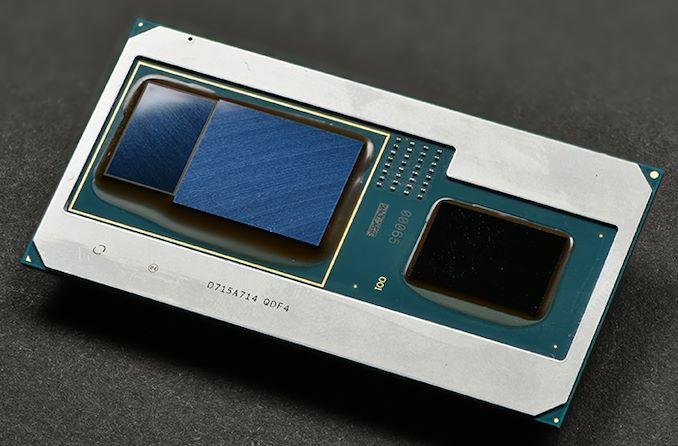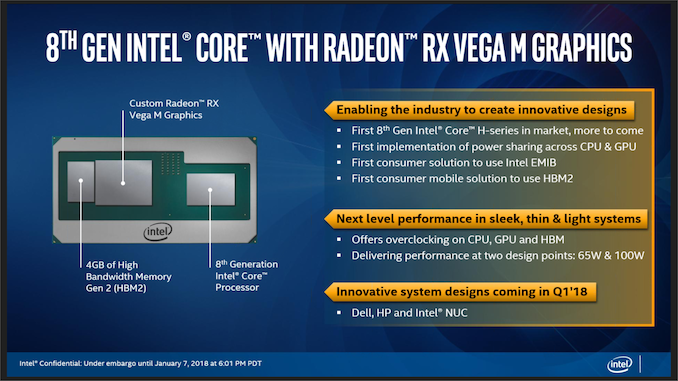Intel Kaby Lake-G GPU Driver Updates Left In Limbo, Currently Unsupported
by Ryan Smith on June 8, 2020 12:00 PM EST
While the retail shelf life of Intel’s unusual Kaby Lake-G processor has pretty much passed at this point, it looks like it has become the gift that keeps on giving when it comes to confusion about how support for the combined Intel/AMD chip will work. First spotted by Tom’s Hardware, AMD’s latest driver Radeon driver installer doesn’t include support for the chip’s AMD “Vega M” GPU, and as a result there are currently no up-to-date drivers available for the platform. And while Tom’s Hardware did get a cryptic-but-promising response from AMD about future driver support, for the moment it’s not clear what’s going to happen or how long-term driver support for the processor will work.
A one-off collaboration between Intel and AMD, Intel’s Kaby Lake-G processor combined a quad-core Intel Kaby Lake CPU with a discrete AMD Polaris-based GPU, all on a single package. With the AMD dGPU covering for Intel’s traditionally weak integrated graphics, Kaby Lake-G gave Intel and interesting chip that could deliver great compute performance and much stronger graphics performance as well.
However since the GPU portion of Kaby Lake-G came from outside Intel, the chip has always existed in an odd place where it’s never been fully embraced by either manufacturer. Even as an Intel-sold and Intel-branded product, Kaby Lake-G’s Radeon roots were never really hidden, and indeed the chip’s GPU drivers have clearly been a derivative of AMD’s standard driver set since the very beginning. But this has also meant that Intel has been reliant on AMD to provide those drivers, and for reasons that are not entirely public or transparent, this hasn’t been handled well. After a very long break between GPU driver updates, Intel essentially gave up on putting any kind of façade on the source of their GPU drivers, and began directing users to install AMD’s Radeon drivers, which at the same time gained official support for the chip.
And that was the end of that. Or so we thought.
Instead, as spotted by the Tom’s Hardware crew, Kaby Lake-G support has once again gone missing from AMD’s drivers. As a result, it’s not possible to install current drivers for the hardware – and even finding drivers that can be installed is a bit of an easter egg hunt.
When they reached out to Intel about the matter – and specifically, about updated drivers for Hades Canyon, Intel’s Kaby Lake-G based NUC – Tom’s Hardware did get a promising, but nonetheless cryptic response from the chipmaker:
And for the moment, this is where things stand, with no official explanation as to what’s going on. Driver support for Kaby Lake-G hangs in limbo, as Intel and AMD seem to be unable to sort out responsibility for the chip.
Joint projects like these are some of the most difficult in the industry, as having multiple vendors involved in a single product means that there’s some degree of cooperation required. Which is easier said than done when it involves historic rivals like Intel and AMD. Still, I would have expected that driver support is something that would have been hammered out in a contract early on – such that AMD was committed to deliver and paid for the necessary 5 years of drivers – rather than the current situation of Intel and AMD seemingly dancing around the issue.
In the meantime, here’s to hoping that Kaby Lake-G’s driver situation gets a happier ending in due time.
Source: Tom's Hardware











46 Comments
View All Comments
EdgeOfDetroit - Monday, June 8, 2020 - link
Weren't we first told about this by [H]ardOCP?DigitalFreak - Monday, June 8, 2020 - link
I miss that site.ND40oz - Wednesday, June 10, 2020 - link
https://www.thefpsreview.com/ has most of their reviewers.psychobriggsy - Monday, June 8, 2020 - link
I'd love to see a (non-APU) Ryzen CPU with discrete RDNA/RDNA2 GPU with HBM in a similar form factor.In fact, Navi 12 is meant to be a HBM-using equivalent of Navi 10, but we never got to see it, although linux driver updates still occur mentioning it, and it was meant to be low power despite the large number of CUs.
Sure, it would be 4 chips in a single small package - HBM, GPU, I/O and CPU, but it'd be nice and compact, if it could be pulled off.
kpb321 - Monday, June 8, 2020 - link
I agree it would be interesting but I don't think we'll see it. As of late AMD has been covering their entire product line with a minimum number of different actual chip designs probably to save mask and layout costs. Their CPU has covered everything from 4 core desktop CPUs up to multi-socket server CPUs with 64 cores and their APU has covered laptops and lower end desktops with some overlap with the low end desktop CPUs. This would end up in an awkward middle ground. Not sharing enough in common with the HEDT and Server space to make it economical and too power hungry to be used in the Laptop APU space to make it economical IMO. Maybe if their future GPU line goes a Chiplet route you could set things up so one of those chiplets could be used in this configuration and give us a pretty capable desktop APU with an 8c/16t cpu chiplet, the IO chiplet a GPU chiplet and the HBM for GPU memory.grrrgrrr - Monday, June 8, 2020 - link
Exactly. Hades Canyon looked really good. I probably would have pulled the trigger if I weren't already using an alienware alpha. Since then I've been waiting for an upgrade. It could be expensive with HBM and everything but it'll make a really nice halo product, and prove that future is better than the past.Wrong_again - Tuesday, June 9, 2020 - link
You'd still need the APU if the chip was going into a laptop. 99% of the time the dGPU in my laptop is unused.grant3 - Monday, June 8, 2020 - link
Disappointing; I would have expected AMD to give top priority to supporting this product as proof that they can be counted on as a reliable partner.DigitalFreak - Monday, June 8, 2020 - link
I don't think AMD is really interested in extremely low volume one-offs.Deicidium369 - Monday, June 8, 2020 - link
Pretty much all they do...